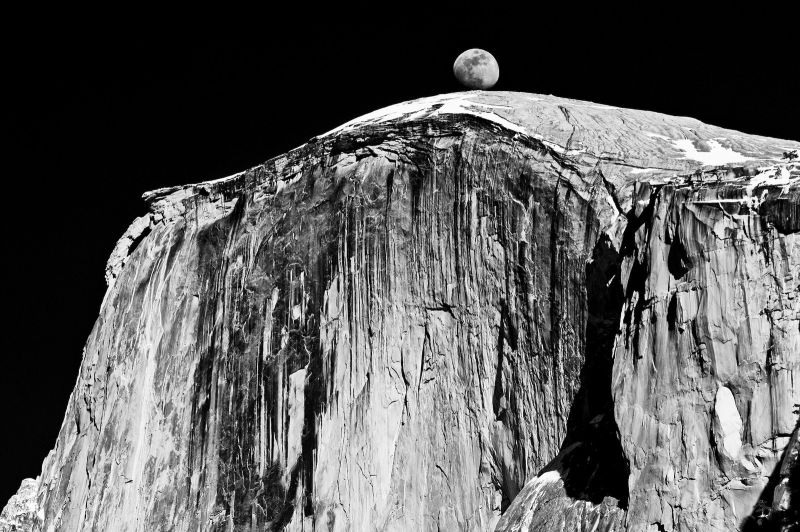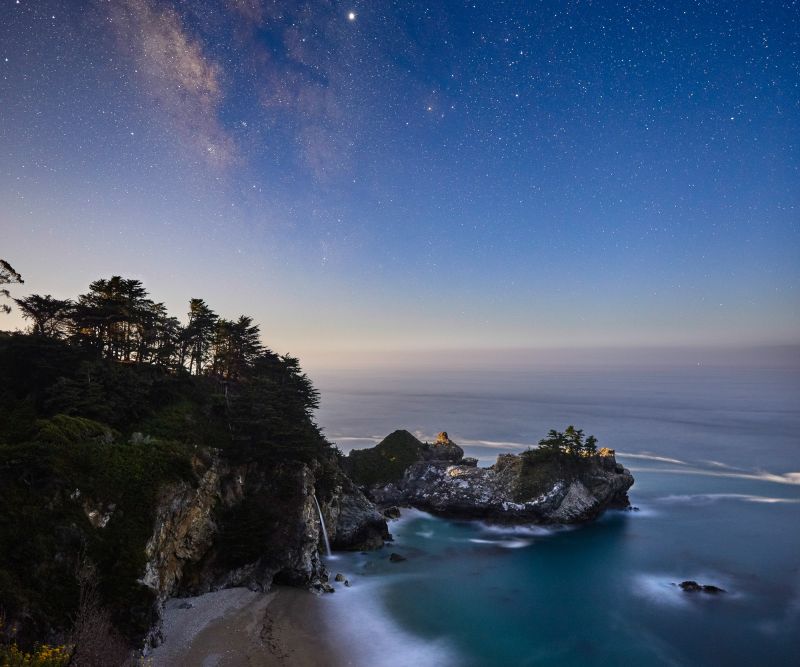
The moon is an exciting photo subject for almost every type of photography! Whether you are a landscape/nightscape photographer, or a portrait or wildlife photographer, you will eventually find yourself either placing the moon in your frame or even using moonlight to illuminate your subject! In short, you should definitely learn the basics of moon photography.

Whether you are timing the full moon rising at sunset, or looking for that perfect crescent moon, the challenge can seem difficult at first, but the steep learning curve is actually quite fun, and very short once you get the hang of it. You might even be ready to photograph the moonrise tonight, or at the next full moon!
In this article, we will cover the different equipment you need, camera settings, and other tips and inspiration. Also, we will cover which mobile phone apps can help you predict precisely where and when the moon will be, and even where to stand for the perfect shot!
Moon Photography | What Equipment Do You Need?

Let’s get this section out of the way as quickly as possible, because honestly, the technical side of capturing beautiful photos of the moon is actually pretty easy! In fact, if you want to skip this whole section, here’s all you need to know:
You don’t need a special camera or a particular lens. Almost any will do just fine! You might decide to invest in a super-telephoto lens at some point, but I can’t recommend that until you’re absolutely sure that you love photographing the moon. Until then, use whatever gear you already own!
Telephoto Lenses & Wide-Angle Lenses for Moon Photography

First of all, if you want the moon to appear large and prominent in your image, you’ll need a telephoto lens. But, exactly which lens is best for moon photography, though? Do you need a fast-aperture zoom lens, such as a 70-200mm f/2.8? Or can you use a slower telephoto zoom with a variable aperture, such as the Tamron 70-300mm f/4.5-6.3?
Either lens will work because the moon is actually a very bright subject. In fact, if you’re a landscape photographer, you will probably spend a lot of your time with our aperture stopped down to f/5.6, f8, or smaller!

The lens you choose has more to do with everything else in your image beside the moon itself, actually! For example, if you do nightscape photography, then you might want an f/2.8 zoom instead of an f/4 zoom.
If you are a portrait photographer who does a lot of work in extremely low light, and you want the moonlight to be even just a part of your exposure, then you will want an f/2.8 zoom or a fast-aperture prime!
Camera Body

Here’s more good news: any camera made in recent years is an excellent camera for moon photographs. Whether it is a full-frame camera or a crop-sensor camera, whether it is mirrorless or a DSLR, you’ll be able to capture gorgeous photos of the moon.
On the one hand, you don’t need a high-speed action camera for photographing pretty much anything related to the moon, except maybe an International Space Station transit. So, don’t worry about having a high frame rate, or flagship-level autofocus tracking.
On the other hand, photographing the moon can often require totally maximizing your sensor’s dynamic range, so that’s one thing to look for. Another thing, of course, is resolution. An epic landscape with a beautiful moonrise sure sounds like something you might want to make a big print of!
Tripod
Any tripod will do; however, if you can, I would recommend getting yourself a strong, heavy tripod. Even if you already own a lightweight travel tripod, that you spent quite a bit of money on, nothing beats a rock-solid beat of a tripod any time you aren’t wandering very far from your car etc.
You don’t have to break the bank here, either, something relatively affordable such as the Slik AMT 700DX will be a stiff, sturdy, almost indestructible tripod that lasts you forever. Compared to your wobbly little travel tripod, this will deliver consistently sharper images, plain and simple.
Cable Release
There aren’t many other accessories that I can truthfully say are essential to photographing the moon, honestly. One tool that many traditional photographers use is a cable release, for clicking your shutter without touching your camera.
These days, though, I have found that 2-sec timer and a fully electronic shutter, if your camera has it, is more than enough to eliminate any camera shake caused by your fingers bumping the camera. (The more likely reason your moon photos are blurry is, a light breeze caused your tripod to wobble or quiver, or you simply didn’t nail manual focus perfectly!)
Moon Photography | Camera Settings

While the camera and lens you use aren’t very important, the settings and techniques you use are. So, let’s break it down:
Shutter Speed
The more telephoto your lens is, the more you will have to be careful which shutter speed you choose. If you’re at 200mm, 300mm, or 400mm, for example, I recommend using a shutter speed faster than between 1/2 sec and 1/4 sec.
If you’re working with a wide-angle lens, though, almost any shutter speed is acceptable, even ones that are quite a few seconds long.
Aperture
Your aperture will depend entirely on the scene and situation you are working in. For distant landscapes with a moderate telephoto focal length, f/4-5.6 could get a good starting point. However, at super-telephoto focal lengths, such as 400mm, 600mm, or 800mm, you will probably find that getting both a subject and the moon in focus becomes more difficult unless your earthbound subject is a mountain on the horizon.
For wide-angle landscapes, astro-landscapes, and portraits, your aperture will be dedicated more by the rest of your scene, and not focusing on the moon.
ISO
For any type of landscape scene, whenever possible, stick to ISO 100 or whichever is your base ISO. (On some cameras it is ISO 64, on others, it may be ISO 160) Your base ISO will give you the best dynamic range in your images, which will be useful if you are photographing a scene with challenging light. (See below for the best advice!)
Use Your Histogram!

Because moon photography will frequently test your camera’s dynamic range, the exposure itself is often more important than any one setting. In other words, you need to get your histogram just right. Actually, “Expose To The Right” or ETTR, is a technique you will want to master!
[Related: What Is A Histogram?]
Basically, the moon will often be the brightest part of your image, so you’ll want to choose your exposure so that the detail in the moon is just barely visible; almost white but not quite clipped or blown out.
To quickly accomplish this objective every time, use your histogram to set your exposure, and then after you’ve captured it, (or during, if you have a camera with “marching ants”) check to make sure the moon isn’t actually “blinking” to indicate clipping.
Then, hopefully, you can see detail in the rest of the scene, even if it is shadowy. If not, you may have to create a bracketed HDR photograph.
Moonrise Time | Calculating Moonrise ?

How To Calculate Moonrise Time
Now, you might be wondering, “this is all useful info, but what I need to know is, when does the moon rise today?” This is an excellent question! The answer, thankfully, is effortlessly simple: there’s an app for that! There are innumerable mobile apps, actually, but my personal favorites are Sun Surveyor and PhotoPills. Either app will give you exact moonrise and moonset times for your location, and tell you where to look on the horizon to see the moon.
Thankfully, the “perfect” moonrise time actually happens quite often, and for those of you who are early birds, you can essentially double your opportunities by getting up at sunrise, and photographing the moonset as well.
In my 2023 Astro-Landscapes photo calendar, I conveniently wrote in each full moon rise and set, each crescent moon rise and set, plus other exciting opportunities every month such as the Milky Way and meteor showers!
Moonrise at Sunset

Every time there is a full moon, (approximately every 29.5 days) the moonrise will be perfectly timed with sunset at least once or twice. The perfect timing for you will not necessarily be on the exact same day as the full moon itself, but will often happen one, two, or three days prior to the full moon. For example, the exact day could depend on if you want to photograph the moon above a tall mountain in your landscape scene, as opposed to over the ocean.
Moonset at Sunrise

For every full moon rising perfectly at sunset, there is also going to be a moonset at sunrise, too! This will happen a few days later, after the full moon has passed its maximum.
You may not want to set your alarm clock for 4, 5, or 6 AM, but in my opinion, it is always worth it!
Crescent Moon at Sunrise & Sunset

Of course, the full moon isn’t the only excellent photography subject. A crescent moon can make an almost otherworldly, sci-fi dreamscape image!
The perfect opportunity for photographing a crescent moon will come at the opposite end of the lunar cycle, near the day of the “new” moon. Here’s the thing, though: The crescent moon will be seen in the same direction as the sunset and/or sunrise. You’ll get a waning crescent moon rising just before sunrise, and you’ll get a waxing crescent moon setting just after sunset.
Look for the perfect opportunities to capture a crescent moon either 2-5 days after a new moon, at sunset, or 2-5 days before a new moon, at sunrise.
Moon Photography | Ideas and Inspiration
Here are some more inspiring moon photography examples! See the caption of each image for basic lens & exposure information.
Moonscapes | Telephoto Landscapes


Wide-Angle Moon Nightscapes | Astro-Landscapes


Cityscape Moonscapes



Portraits Under Moonlight

One of the most impressive types of portraits that few other portrait photographers are brave enough to attempt is the nightscape portrait. Especially when there is moonlight in the night sky, the reward is always worth the effort!
You already have a tripod, and if you’re a portrait or wedding photographer then you probably already have portable flashes you can use. Simply have your subject(s) hold as still as possible for 1-2 seconds. In a wide-angle nightscape portrait, especially with the pop of a flash to freeze them, your results can be jaw-dropping.
Long Exposure Moonscapes

Of course, if you want to break all the rules, you can start thinking outside the box and get
Conclusion | Moon Photography Tips
Grab your camera and tripod, and go photograph the moonrise tonight! (Or, just ask Siri or Alexa, “when is the full moon this month?”)
Joking aside, the truth is that opportunities for a beautiful moon photograph are so abundant, there is at least one almost every week! So, whether you are a landscape photographer, or a portrait or wedding photographer
Matthew Saville
Follow his wilderness nightscape adventures on Instagram: instagram.com/astrolandscapes




Get Connected!